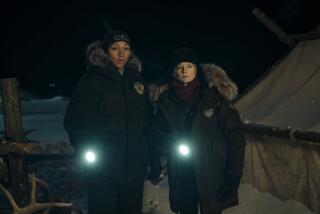‘I GUESS PEOPLE DON’T KNOW HOW TO PLACE ME’
- Share via
Irene Bedard, who plays Mary Crow Dog in “Lakota Woman: Seige at Wounded Knee,” grew up in a small village in Alaska. The actress of Cree and Inupiat Eskimo heritage now lives in New York City, where she runs her own Native American theater company.
In that metropolitan melting pot, Bedard rarely encounters racism. “People ask me (in my work), ‘I know you are something.’ Usually I ask them to guess because nobody ever guesses Native American. They go ‘Asian? Hispanic?’ I play a lot of offbeat people. I guess people don’t know how to place me.”
But she found racism first-hand last fall in Rapid City, S.D., while there on location to make the TNT film airing this week.
“I stayed at a hotel,” Bedard recounts. “A couple of times they sent cops to people’s rooms. They would send bell people to check on us. I’m doing this movie, so obviously I have the money to pay my incidental bills, but after the third time I ordered something in, they said, ‘The manager thought it would be better if you paid for your dinner now.’
“I’d go to shopping malls and be followed around wherever I went. I said, ‘Look, I have a whole shopping cart full of things, I am not going to walk through the front door with it.’ ”
Bedard, who also appears in Disney’s upcoming film “Squanto: A Warrior’s Tale,” fell in love with Crow Dog’s autobiography “Lakota Woman” four years ago and wanted to adapt it for a one-woman show. But Jane Fonda had already optioned the bestseller. “It was something I love and had my heart in it,” she says. “And then here I was auditioning for the film. I couldn’t believe it.”
Unlike the real Mary Crow Dog, Bedard was never sent to a Catholic missionary school and be forced to assimilate. But her mother was.
“She grew up in a little village and then she tried to fit into a world where Elvis is king and airplanes land,” she says. “I understand the concept (of assimilation). They didn’t build schools anywhere near (the village). They sent children to Oregon. Basically you are uprooting someone and not letting them speak your language. If you get the image of someone who sits around the fire and tells stories and sings songs and then goes to a place where it is barren. ... It’s a completely different way of thinking and it confused a lot of people.
“It’s an odd thing,” Bedard reflects. “When I was up on Nova Scotia shooting ‘Squanto,’ I was just sitting out there on the beach. I just looked at the ocean and it just sort of struck me that all of these people, these smiling, loving people who really have a beautiful way of speaking and thinking about the world, are gone. I just started to cry.”
More to Read
Only good movies
Get the Indie Focus newsletter, Mark Olsen's weekly guide to the world of cinema.
You may occasionally receive promotional content from the Los Angeles Times.








